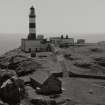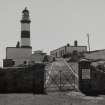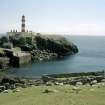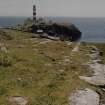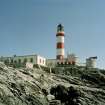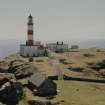Scalpay, Eilean Glas Lighthouse, Old Lighthouse
Lighthouse (18th Century)
Site Name Scalpay, Eilean Glas Lighthouse, Old Lighthouse
Classification Lighthouse (18th Century)
Alternative Name(s) Scalpaigh; North Minch
Canmore ID 268310
Site Number NG29SW 1.01
NGR NG 24740 94710
Datum OSGB36 - NGR
Permalink http://canmore.org.uk/site/268310
- Council Western Isles
- Parish Harris
- Former Region Western Isles Islands Area
- Former District Western Isles
- Former County Inverness-shire
Circular lighthouse tower, superseded by a tower designed by Robert Stevenson circa 1825 , with a house adjoining the original tower, itself converted to store also probably 1825. This is a classic example of a lighthouse complex which encompasses the lighthouse, accommodation for the keepers and their families, means of transport with the jetty and a means of subsistence with fields and walled garden. It forms a distinctive grouping in a remarkable setting. This site also documents the development of the lighthouse with the earlier tower being one of the first 4 lighthouses commissioned by the Northern Lighthouse Board, which had been formed 3 years earlier. (Historic Scotland)
Captain Alex McLeod of Harris, the owner of Scalpay, on being approached by the original Northern Lighthouse Trustees in 1787, engaged the services of his local Tacksman, Mr Campbell to provide the necessary building material and to engage the services of local workmen. He also recommended Mr Campbell as a suitable person for the supervision of the work. The Trustees indicated that they did not require Mr Campbell's services other than for the procurement of building materials and made arrangements to send their own masons to erect the Lighthouse. However, Captain McLeod did in fact engage Mr Campbell and his local workmen to lay the foundations and raise the Tower Wall to a height of seven feet in the summer of 1787. The Trustees' engineer, Thomas Smith, had found, on preliminary inspection visit, that McLeod's men and made the circumference of the tower four feet greater than as shown on the plans but to save time and expense, authorised Shiells to proceed on this larger scale. The work on the interior of the building was entrusted to Archie McVicar, Joiner, of North Uist. (Northern Lighthouse Board)
Construction (1787 - 1789)
One of the first four lighthouses built in Scotland. Light established in 1789.
R W Munro 1979
Field Visit (3 June 1997)
This was one of the four first lighthouses in Scotland. Begun in 1787, the lamp was first lit on the 10th October 1789. The current tower and dwellings date from c1826 (engineer Robert Stevenson). The light had been automated, the dwellings were unoccupied and the old tower and house were in a bad state of repair on the date of visit.
Visited by RCAHMS (MKO), 3 June 1997.
Project (4 June 2015 - 5 June 2015)
A condition survey of the Eilean Glas lighthouse complex, Scalpay, undertaken on behalf of Comhairle nan Eilean Siar on 4 and 5 June 2015.
Field Visit (4 June 2015 - 5 June 2015)
One of the first four lighthouses constructed by the Northern Lighthouse Commissioners, this circular stone tower was completed in 1789 to the designs of Robert Kay and Thomas Smith. It remained operational until 1824, when it was superseded by a new tower designed by Robert Stevenson (118898). It appears to have been truncated slightly, probably coinciding with re-roofing after it was decommissioned. It currently only survives to a height of two storeys, although evidence of a third is visible. Half-way up the first floor the wall thickness reduces significantly; this may have been a result of the initial phases of construction not being executed to the intended design.
The tower is accessed via an internal door from the adjoining former keeper’s cottage (350404) to the north, and by an external timber boarded door to the east. There are small windows to the south and north-east. The exterior is lime-washed white; a projecting sandstone course marks the narrowing of the wall thickness in the upper levels. An octagonal chimney protrudes from the northwest exterior of the tower at first floor level. The tower is currently capped by a circular timber beam roof partially covered by sarking boards. Internally the fireplace has been blocked and rendered over; a timber bench structure survives under the window.
One of the first four lighthouses constructed by the Northern Lighthouse Commissioners, construction began on Eilean Glas lighthouse in 1787 . It was first lit on 10 October 1789, and the site has continued to operate through successive phases of development to the present day. The development of the lighthouse can be summarised in four phases: the construction of the first lighthouse and associated buildings in 1787-9; the construction of the second (current) lighthouse and associated buildings in 1824; the construction of a new keeper’s cottage and foghorn in the early twentieth century; and the development of technological infrastructure during the twentieth century, including aerial masts and the helipad.
This structure dates from the first period of the site’s development. The first lighthouse to be constructed at Eilean Glas was a stone tower (268310) with an adjoining keeper’s cottage (350404). A plan of 1813 shows the lighthouse flanked by a courtyard to the east, accessed by a track from the pier (268312), which appears at this point to have functioned as a wharf for loading directly from South Harbour . Also shown is a storehouse near the pier, presumably the same structure that still survives today (268313). The field system, used by the lighthouse keeper to grow food during the day, is shown at its full extent at this point, although only the southern portion is shown as being under cultivation, and the path system is yet to be fully developed.
The lighthouse was automated in 1978, which resulted in the majority of structures on the site no longer being required by the NLB . In 1982 and 1984 these were sold into private ownership . At this point a modern foghorn and an aerial mast were still operational; these have since been decommissioned.

















